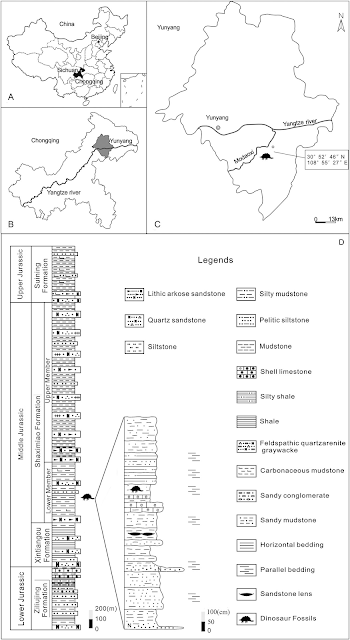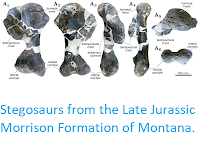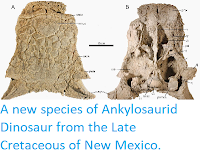The Stegosaurs were a distinctive group of Ornithischian Dinosaurs whose fossils are known from the Middle Jurassic to the Early Cretaceous, and which are distinctive for the presence of a double row of plates or spines which run along the back from the neck to the tip of the spine. The earliest known Stegosaurs appear in the Middle Jurassic in Europe, China, Argentina, and Morocco, a distribution which implies the group emerged some time before the oldest fossils we know.
In a paper published in the Journal of Vertebrate Paleontology on 3 March 2022, Dai Hui and Li Ning of the Chongqing Laboratory of Geoheritage Protection and Research at the Chongqing Bureau of Geological and Mineral Resource Exploration and Development, Susannah Maidment of the Department of Earth Sciences at the Natural History Museum, Wei Guangbiao of the Chongqing Institute of Geological Survey, Zhou Yuxuan, Hu Xufeng, Ma Qingyu, Wang Xunqian, and Hu Haiqian, also of the Chongqing Laboratory of Geoheritage Protection and Research, and Peng Guangzhao of the Zigong Dinosaur Museum, describe a new species of Stegosaur from the Middle Jurassic Lower Member of the Shaximiao Formation of Chongqing Municipality, China.
The new species is described upon the basis of material from the Dinosaur Quarry at Laojun Village, a site discovered in 2017, and which has been excavated systematically to form a wall of Dinosaur fossils 150 m long and 8 m high. The Lower Member of the Shaximiao Formation comprises grayish-yellow massive fine-grained lithic feldspathic sandstones and purplish red silty mudstones in multiple rhythmic layers of uneven thickness; the siltstones contain calcareous nodules. This 'redbed' facies is interpretted to indicate a semi-arid, terrestrial paleoenvironment. Various attempts have been made to date this bed radiometrically, yielding dates of between 158 and 172 million years old.
The new species is named Bashanosaurus primitivus, where 'Bashanosaurus' is a combination of 'Bashan-', an ancient name for Chongqing, and '-saurus', meaning 'Lizard', a comon suffix for Dinosaur names, and 'primitivus' refers to the fact that a phylogenetic analysis revealed the species to be the most primitive member of the Stegosauria (that it is to say it is the earliest branching member of the group, with all other Stegosaurs being more closely related to one-another than they are to Bashanosaurus primitivus). The new species is described from three specimens, CLGPR V00006-1, V00006-2, and V00006-3, all from the 'wall' of Dinosaur specimens from the Dinosaur Quarry at Laojun Village.
Specimen CLGPR V00006-1 is designated the holotype of the species (that is to say, any other specimen which is judged to be the same species as CLGPR V00006-1 is therefore considered to be a specimen of Bashanosaurus primitivus). This specimen is preserved on the west side of the wall of Dinosaur fossils and comprises one dorsal vertebra, two caudal vertebrae, right scapula, right coracoid, left femur, left tibia, left fibula, one metatarsal, three pieces of dermal armor (1 plate and 2 spines) and some ribs. Specimen CLGPR V00006-2 is preserved in the middle of the wall of Dinosaur fossils, and comprises five dorsal vertebrae, right tibia, right fibula, one piece of dermal plate, and some ribs. CLGPRV00006-3 is a dorsal vertebra from the east side of the wall of Dinosaur fossils.
Bashanosaurus primitivus shows a number of distinctive features not seen in any previously described Stegosaur. These include parapophyses of dorsal vertebrae, which are elevated on stalks at the base of the transverse process, the shape of the scapula blade, which is slender and flares distally, the acromial process of the scapula, which is small, triangular and poorly developed, the 4th trochanter of the femur, which is positioned below the middle of the shaft, and the bases of the dermal plates, which are strongly convex and transversely thickened, and are separated from the anterior/posterior margins of the plates by a distinct groove.
A fourth Stegosaur specimen, CLGPR V00006-4, was recovered from an exploratory trench, about 900 m away from the Dinosaur Fossil Wall. This specimen comprises a partial cranium, a dorsal vertebra, and a piece of dermal armour, which is not sufficient to assign it two species level, since two Stegosaur species have now been described from the Lower Member of the Shaximiao Formation, Bashanosaurus primitivus, and Huayangosaurus taibaii, which was described in 1984, from material from the Shaximiao Formation in of Sichuan Province.
A phylogenetic analysis, based upon a previous study of the group published by a team led by Sussanah Maidment in 2020, found that Bashanosaurus primitivus is the sister taxon to Chungkingosaurus jiangbeiensis, a Stegosaur from the Late Jurassic Upper Member of the Shaximiao Formation, and that together these two species form a sister group to all other Stegosaurs.
Dai et al. also carried out a radiometric analysis of the deposits which produced Bashanosaurus primitivus, using thorium/uranium ratios in detrital zircons (uranium-thorium dating works because uranium decays to thorium at a known rate, so that the ratio of the two elements in minerals that naturally incorporate uranium but not thorium can be used to establish a date for the minerals). This produced a range of ages, which would be expected from durable minerals in sedimentary rocks, but the youngest were dated to roughly 169 million years old, implying that the rocks of the Lower Member of the Shaximiao Formation were deposited no earlier than the Bajocian Stage of the Middle Jurassic.
If the Lower Member of the Shaximiao Formation is Bajocian in origin, then that would make the Stegosaurs found within it, Bashanosaurus primitivus and Huayangosaurus taibaii, the oldest known Stegosaur speciemens. Since Huayangosaurus taibaii is the next branching clade within the Stegosauria after the clade that comprises Bashanosaurus primitivus and Chungkingosaurus jiangbeiensis, this strongly supports an Asian origin for the Stegosauria as a whole.
Dai et al.'s results suggest that the Lower Member of the Shaximiao Formation at Dinosaur Quarry at Laojun Village is Middle Jurassic in age. However, another recent study has suggested that the Lower Member of the Shaximiao Formation at Zigong in Sichuan Province should be dated to the Late Jurassic. Dai et al. suggest that this is because, in the Middle Jurassic, the centre of deposition within the Sichaun Basin (which contains the Shaximiao Formation) was in the northeast, shifted over time due to the rapid filling of the basin by material derived from the intracontinental subduction of the Qinling orogenic belt and Daba Mountains, with the upshot that the Shaximiao Formation may be laterally diachronous (that is to say of different ages across it's horizontal extent). If this is the case, then the rocks which produced Huayangosaurus taibaii may be younger than those which produced Bashanosaurus primitivus, even though they are part of the same member of the same formation.
Bashanosaurus primitivus is therefore the oldest known Stegosaur in Asia, and one of the oldest known Stegosaurs in the world, with geochronological data supporting a Bajocian age for the Lower Member of the Shaximiao Formation at Dinosaur Quarry. Bashanosaurus primitivus is also one of the earliest branching Stegosaurs phylogenetically, forming a clade with Chungkingosaurus jiangbeiensis that forms the sister group to all other Stegosaurs. This strongly supports the hypothesis that the Stegosauria as a whole had an Asian origin.
See also...



Online courses in Palaeontology.
Follow Sciency Thoughts on Facebook.
Follow Sciency Thoughts on Twitter.








